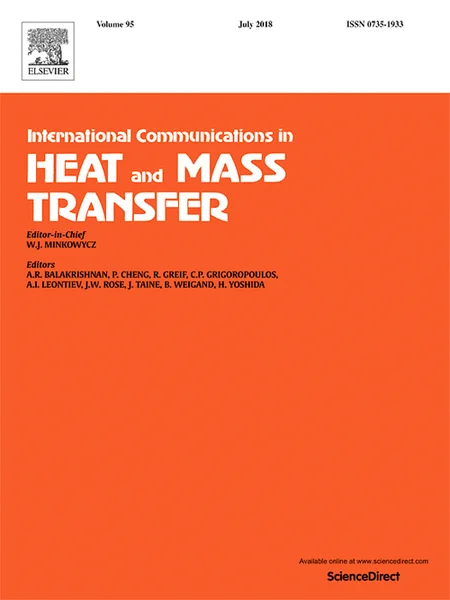-
numerical investigation of heat transfer and pressure drop in enhanced tubes
جزئیات بیشتر مقاله- تاریخ ارائه: 1397/06/10
- تاریخ انتشار در تی پی بین: 1397/06/10
- تعداد بازدید: 287
- تعداد پرسش و پاسخ ها: 0
- شماره تماس دبیرخانه رویداد: -
this study investigates passive heat transfer enhancement techniques to determine the distribution of temperature and static pressure in test tubes, the friction factor, the heat flux, the temperature difference between the inlet and outlet fluid temperatures, the pressure drop penalty and the numerical convective heat transfer coefficient, and then compares the results to the experimental data of zdaniuk et al. it predicts the single-phase friction factors for the smooth and enhanced tubes by means of the empirical correlations of blasius and zdaniuk et al. this study performed calculations on a smooth tube and two helically finned tubes with different geometric parameters also used in the analyses of zdaniuk et al. it also performed calculations on two corrugated tubes in the simulation study. in zdaniuk et al.'s experimental setup, the horizontal test section was a 2.74 m long countercurrent flow double tube heat exchanger with the fluid of water flowing in the inner copper tube (15.57–15.64 mm i.d.) and cooling water flowing in the annulus (31.75 mm i.d.). their test runs were performed at a temperature around 20 °c for cold water flowing in the annulus while reynolds numbers ranged from 12,000 to 57,000 for the water flowing in the inner tube. a single-phase numerical model having three-dimensional equations is employed with either constant or temperature dependent properties to study the hydrodynamics and thermal behaviors of the flow. the temperature contours are presented for inlet, outlet and fully developed regions of the tube. the variations of the fluid temperature and static pressure along tube length are shown in the paper. the results obtained from a numerical analysis for the helically tubes were validated by various friction factor correlations, such as those found by blasius and zdaniuk et al. then, numerical results were obtained for the two corrugated tubes as a simulation study. the present study found that the average deviation is less than 5% for the friction factors obtained by the fluent cfd program while blasius's correlation has the average deviation of less than 10%. the corrugated tubes have a higher heat transfer coefficient than smooth tubes but a lower coefficient than helically finned tubes. the paper also investigates the pressure drop penalty for the heat transfer enhancement.
مقالات جدیدترین رویدادها
-
استفاده از تحلیل اهمیت-عملکرد در ارائه الگوی مدیریت خلاقیت سازمانی و ارائه راهکار جهت بهبود
-
بررسی تاثیر ارزش وجوه نقد مازاد بر ساختار سرمایه شرکت های پذیرفته شده در بورس اوراق بهادار تهران
-
بررسی تأثیر سطح افشای ریسک بر قرارداد بدهی شرکت های پذیرفته شده در بورس اوراق بهادار تهران
-
بررسی تأثیر رتبه بندی اعتباری مبتنی بر مدل امتیاز بازار نوظهور بر نقد شوندگی سهام با تأکید بر خصوصی سازی شرکت ها
-
تأثیر آمیخته بازاریابی پوشاک ایرانی بر تصویر ذهنی مشتری پوشاک ایرانی (هاکوپیان)
-
واکاوی ارکان، اجزا و شرایط جرم انتقال مال غیر در نظام حقوق کیفری ایران
-
ارزیابی پارامترهای موثر بر زمین لغزش در حوزه آبخیز اعلاء- رود زرد باغملک با استفاده از تکنیک های سنجش از دور، gis و روش های آماری
-
تاثیر هیپرمی غیر فعال بر استرین شعاعی شریان بازویی: تعیین موقعیت بهینه کاف
-
بررسی اثر هوش هیجانی بر تعارضات سازمانی در شعب بانک صادرات قزوین
-
computations of hydrodynamic coefficients, displacement-amplitude ratios and forces for a floating cylinder due to wave diffraction and radiation
مقالات جدیدترین ژورنال ها
-
مدیریت و بررسی افسردگی دانش آموزان دختر مقطع متوسطه دوم در دروان کرونا در شهرستان دزفول
-
مدیریت و بررسی خرد سیاسی در اندیشه ی فردوسی در ادب ایران
-
واکاوی و مدیریت توصیفی قلمدان(جاکلیدی)ضریح در موزه آستان قدس رضوی
-
بررسی تاثیر خلاقیت، دانش و انگیزه کارکنان بر پیشنهادات نوآورانه کارکنان ( مورد مطالعه: هتل های 3 و 4 ستاره استان کرمان)
-
بررسی تاثیر کیفیت سیستم های اطلاعاتی بر تصمیم گیری موفق در شرکتهای تولیدی استان اصفهان (مورد مطالعه: مدیران شرکتهای تولیدی استان اصفهان)
-
مبانی نظریه اختیارات زوجه از جانب زوج ناشی از رابطه زناشویی در حقوق انگلیس و ایران
-
بررسی حقوق اسرار تجاری در روابط قراردادی و غیرقراردادی در حقوق ایران با نگاه تطبیقی در حقوق آمریکا
-
بررسی رابطه بین تعارض و سلامت سازمانی با توجه به نقش تعدیل گر سرمایه روان شناختی (مطالعه موردی: اداره کل دامپزشکی استان خراسان رضوی)
-
مهندسی ارزش مفاهیم، نظریه ها، تنگناها، چالشها
-
re-visiting the park: reviving the “cultural park for children” in sayyeda zeinab in the shadows of social sustainability




سوال خود را در مورد این مقاله مطرح نمایید :